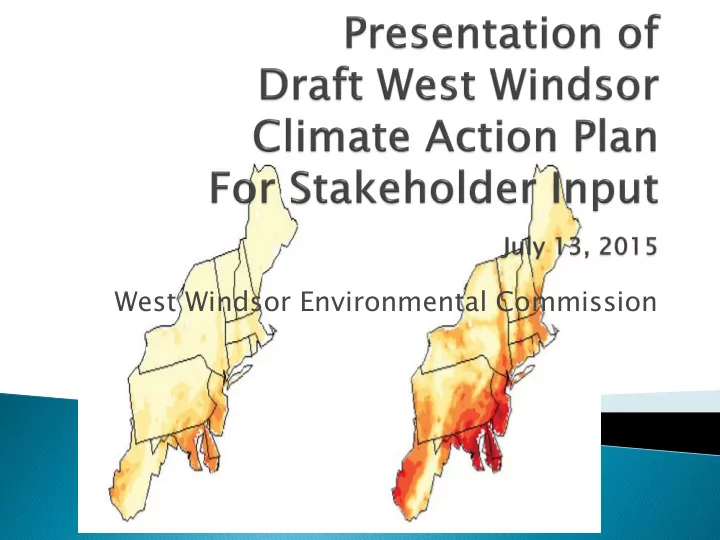

West Windsor Environmental Commission
Summarizes the science and the risks Estimates greenhouse gas emissions (our carbon footprint) Sets emission reduction goal Proposes a plan of action Initiates a discussion on planning for climate change
We are already beginning to experience a changing climate The climate is changing principally due to an increasing concentration of GHGs in the atmosphere, particularly carbon dioxide (CO2) GHGs trap heat in the atmosphere, causing global warming
Combustion of fossil fuels for transportation, electricity generation, building heating and industrial processes is the principal sources of anthropogenic CO2 The CO2 concentration in the atmosphere has recently reached the 400 part per million (PPM) level, and is rising at a rate of two parts per million per year
Our area can expect increasing: Heat t Wave ves Intense ense Pr Preci cipit itati ation on Flo loodin ing g Residents, environment and infrastructure (such as electric grid) will be increasingly vulnerable. Many states and towns are making preparations.
West Windsor sor Townsh ship ip emitted 340,0 ,000 00 metric tons of f CO2 equiva vale lents nts in 2012: Ninety y nine percent nt (340, 0,00 000 0 metric c tons) of the Township’s emissions were fr from the communit nity y at large Only y one percent nt (3,5 ,500 00 metric tons) ) results ts fr from municipa ipal operati tions ons
Proposed goal = NJ’s Global Warming Response Act: ◦ Stabilization of greenhouse gas emissions at 1990 levels by 2020 ◦ Reduction of emissions to 80 percent below 2006 levels by 2050 Overall reduction needed: 96,000 metric tons between the present and 2020: ◦ 50,000 metric tons due to “Business as Usual” (e.g. increased vehicle MPG) ◦ 46,000 metric ton reduction requires active CAP program
Implement energy audit recommendations Building retro-commissioning Employee awareness Efficient vehicles Waste reduction Promote alternatives to single vehicle use purchasing green electricity Community education programs
Transportation ◦ Reduce vehicle miles traveled ◦ Promote transition to more efficient/ alternative fueled vehicles ◦ Provide employee incentives for walking, biking, carpooling, or using mass transit ◦ Bolster Anti-Idling program Increase awareness of energy efficiency incentives Improve waste reduction and recycling Energy star purchases
Anticipate increased heat waves, droughts, flooding and power outages Consider effects on vulnerable citizens, such as senior citizens Consider effects on public health, transportation, utilities/power, emergency services Raise awareness among residents about the need for preparation and self-reliance Implement Little Bear Brook Flood Hazard Assessment Study? Monitor New Jersey Climate Adaption Alliance
Stakeholder review ◦ Municipal Officials ◦ Community Groups, Residents, Businesses Municipal adoption of “purpose and intent” Implementation and reporting
Scientists ientists Ag Agre ree: There’s Hope: • It’s Us • Reduce duce • It’s Bad Emi missions ssions • It’s Getting • Pre repare pare Worse rse • Stay ay Informed formed
Recommend
More recommend